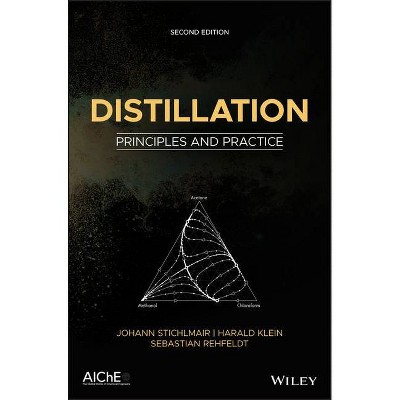Distillation - 2nd Edition by Johann G Stichlmair & Harald Klein & Sebastian Rehfeldt (Hardcover)

Similar Products
Products of same category from the store
AllProduct info
<p/><br></br><p><b> About the Book </b></p></br></br>"Distillation Principles and Practice Second Edition covers all the main aspects of distillation including the thermodynamics of vapor/liquid equilibrium, the principles of distillation, the synthesis of distillation processes, the design of the equipment, and the control of process operation. Most textbooks deal in detail with the principles and laws of distilling binary mixtures. When it comes to multi-component mixtures, they refer to computer software nowadays available. One of the special features of the second edition is a clear and easy understandable presentation of the principles and laws of ternary distillation. The right understanding of ternary distillation is the link to a better understanding of multi-component distillation. Ternary distillation is the basis for a conceptual process design, for separating azeotropic mixtures by using an entrainer, and for reactive distillation, which is a rapidly developing field of distillation. Another special feature of the book is the design of distillation equipment, i.e. tray columns and packed columns. In practice, empirical know-how is preferably used in many companies, often in form of empirical equations, which are not even dimensionally correct. The objective of the proposed book is the derivation of the relevant equations for column design based on first principles. The field of column design is permanently developing with respect to the type of equipment used and the know-how of two-phase flow and interfacial mass transfer."--<p/><br></br><p><b> Book Synopsis </b></p></br></br><b>Distillation Principles and Practice Second Edition</b> covers all the main aspects of distillation including the thermodynamics of vapor/liquid equilibrium, the principles of distillation, the synthesis of distillation processes, the design of the equipment, and the control of process operation.Most textbooks deal in detail with the principles and laws of distilling binary mixtures. When it comes to multi-component mixtures, they refer to computer software nowadays available. One of the special features of the second edition is a clear and easy understandable presentation of the principles and laws of ternary distillation. The right understanding of ternary distillation is the link to a better understanding of multi-component distillation. Ternary distillation is the basis for a conceptual process design, for separating azeotropic mixtures by using an entrainer, and for reactive distillation, which is a rapidly developing field of distillation.<br />Another special feature of the book is the design of distillation equipment, i.e. tray columns and packed columns. In practice, empirical know-how is preferably used in many companies, often in form of empirical equations, which are not even dimensionally correct. The objective of the proposed book is the derivation of the relevant equations for column design based on first principles. The field of column design is permanently developing with respect to the type of equipment used and the know-how of two-phase flow and interfacial mass transfer.<p/><br></br><p><b> From the Back Cover </b></p></br></br><p><b>Distillation Principles and Practice Second Edition</b> covers all the main aspects of distillation including the thermodynamics of vapor/liquid equilibrium, the principles of distillation, the synthesis of distillation processes, the design of the equipment, and the control of process operation. <p>Most textbooks deal in detail with the principles and laws of distilling binary mixtures. When it comes to multi-component mixtures, they refer to computer software nowadays available. One of the special features of the second edition is a clear and easy understandable presentation of the principles and laws of ternary distillation. The right understanding of ternary distillation is the link to a better understanding of multi-component distillation. Ternary distillation is the basis for a conceptual process design, for separating azeotropic mixtures by using an entrainer, and for reactive distillation, which is a rapidly developing field of distillation. <p>Another special feature of the book is the design of distillation equipment, i.e. tray columns and packed columns. In practice, empirical know-how is preferably used in many companies, often in form of empirical equations, which are not even dimensionally correct. The objective of the proposed book is the derivation of the relevant equations for column design based on first principles. The field of column design is permanently developing with respect to the type of equipment used and the know-how of two-phase flow and interfacial mass transfer.<p/><br></br><p><b> About the Author </b></p></br></br><p><b>JOHANN STICHLMAIR PHD, </b> is the Emeritus of the Institute of Plant and Process Technology, Technical University of Munich. He is the winner of the Arnold Eucken Award 1978, the Emil Kirschbaum Medal 2003 and the Arnold Eucken Medal 2008 of the German Association of Chemical Engineers. He was also honored in a special session at the AIChE National Meeting in 2004. <p><b>HARALD KLEIN PHD, </b> is the current head of the Institute of Plant and Process Technology at the Technical University of Munich. His research is based on modeling and simulation of chemical processes, equipment design as well as thermodynamic property data. <p><b>SEBASTIAN REHFELDT PHD, </b> is a senior lecturer for equipment design and process design at the Technical University of Munich. His research concentrates on gas-liquid contact apparatus and heat exchangers.
Price History
Cheapest price in the interval: 195 on November 8, 2021
Most expensive price in the interval: 195 on December 20, 2021
Price Archive shows prices from various stores, lets you see history and find the cheapest. There is no actual sale on the website. For all support, inquiry and suggestion messagescommunication@pricearchive.us



















